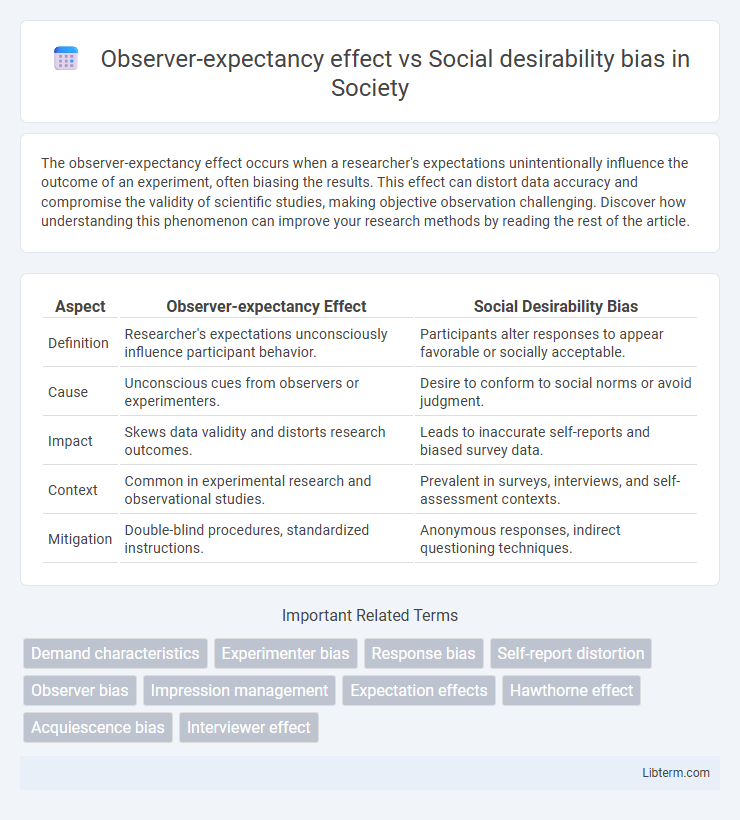The observer-expectancy effect occurs when a researcher's expectations unintentionally influence the outcome of an experiment, often biasing the results. This effect can distort data accuracy and compromise the validity of scientific studies, making objective observation challenging. Discover how understanding this phenomenon can improve your research methods by reading the rest of the article.
Table of Comparison
| Aspect | Observer-expectancy Effect | Social Desirability Bias |
|---|---|---|
| Definition | Researcher's expectations unconsciously influence participant behavior. | Participants alter responses to appear favorable or socially acceptable. |
| Cause | Unconscious cues from observers or experimenters. | Desire to conform to social norms or avoid judgment. |
| Impact | Skews data validity and distorts research outcomes. | Leads to inaccurate self-reports and biased survey data. |
| Context | Common in experimental research and observational studies. | Prevalent in surveys, interviews, and self-assessment contexts. |
| Mitigation | Double-blind procedures, standardized instructions. | Anonymous responses, indirect questioning techniques. |
Introduction to Observer-Expectancy Effect and Social Desirability Bias
The observer-expectancy effect occurs when a researcher's expectations unintentionally influence participants' behavior, leading to biased outcomes in experimental settings. Social desirability bias manifests when individuals alter their responses to conform to perceived social norms or gain approval, distorting self-reported data. Both phenomena compromise the validity of research findings by introducing systematic errors related to human cognition and social behavior.
Defining Observer-Expectancy Effect
Observer-expectancy effect refers to a form of experimental bias where a researcher's expectations unconsciously influence the participants' behavior or the outcome of the study, often distorting results. This effect occurs through subtle cues or body language that can lead subjects to act in ways that confirm the experimenter's hypotheses. Unlike social desirability bias, which is driven by participants' desire to present themselves favorably, the observer-expectancy effect originates from the researcher's influence on the data collection process.
Understanding Social Desirability Bias
Understanding social desirability bias involves recognizing how individuals alter responses to align with perceived social norms, often skewing research data. This bias significantly impacts self-reported measures, especially in sensitive topics such as mental health, substance use, and attitudes toward stigmatized behaviors. Distinct from the observer-expectancy effect--which arises from researchers' expectations influencing participants--social desirability bias originates from participants' desire to be viewed favorably by others.
Key Differences Between Observer-Expectancy Effect and Social Desirability Bias
Observer-expectancy effect occurs when a researcher's expectations unconsciously influence participants' behaviors or responses, potentially skewing experimental outcomes. Social desirability bias involves participants altering their answers or actions to conform to perceived societal norms or to present themselves favorably. The key difference lies in the source of bias: observer-expectancy effect originates from the experimenter, while social desirability bias stems from the participants' desire for social approval.
Psychological Mechanisms Behind Each Bias
The observer-expectancy effect occurs when a researcher's expectations unconsciously influence participant behavior, driven by subtle cues and nonverbal signals that shape outcomes without overt instruction. Social desirability bias arises from individuals' motivation to present themselves favorably, often leading to distorted self-reports influenced by cultural norms and the desire for social approval. Both biases involve underlying psychological mechanisms: the observer-expectancy effect relies on unconscious cognitive processes in the experimenter, while social desirability bias stems from conscious impression management and self-presentation strategies in participants.
Real-World Examples: Observer-Expectancy Effect
In clinical trials, the observer-expectancy effect can skew results when researchers unintentionally communicate expectations to participants, influencing their responses, as seen in early drug efficacy studies. In wildlife research, observer bias affects animal behavior data when the presence or expectations of researchers alter natural activities, demonstrated in studies of primate social interactions. Classroom observations reveal teacher expectations impacting student performance, highlighting observer-expectancy effects in educational assessments.
Real-World Examples: Social Desirability Bias
In market research, social desirability bias often skews survey results as respondents tend to provide answers they believe are socially acceptable rather than truthful, such as overstating environmentally friendly behaviors. During employee performance reviews, workers may present themselves in an unrealistically positive light to align with company values, causing inflated self-assessments. Health studies frequently encounter this bias when participants underreport alcohol consumption or smoking habits to avoid stigma.
Impact on Research Validity and Data Collection
Observer-expectancy effect and social desirability bias both significantly impact research validity by introducing systematic errors during data collection. The observer-expectancy effect occurs when researchers unconsciously influence participant behavior, compromising the objectivity of experimental outcomes. In contrast, social desirability bias leads participants to alter their responses to align with perceived social norms, resulting in distorted self-reported data and reduced accuracy.
Strategies to Minimize Observer-Expectancy Effect and Social Desirability Bias
Implementing double-blind study designs and using automated data collection methods effectively minimize the observer-expectancy effect by reducing researcher influence on participants. To combat social desirability bias, employing anonymous surveys and indirect questioning techniques encourages honest responses while protecting participant privacy. Combining these strategies enhances data validity by curbing both researcher-related and participant-related biases in behavioral research.
Conclusion: Addressing Biases for Accurate Research
Addressing observer-expectancy effect and social desirability bias is critical for enhancing research accuracy by implementing double-blind study designs and ensuring participant anonymity. Utilizing objective measurement tools and emphasizing honest responses reduces the risk of skewed data. These strategies minimize bias impact, contributing to credible and reliable research outcomes.
Observer-expectancy effect Infographic

 libterm.com
libterm.com